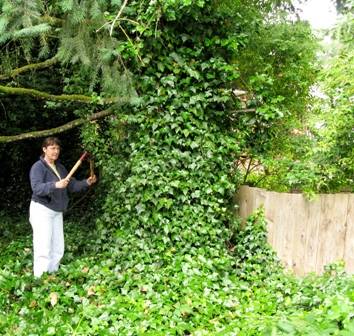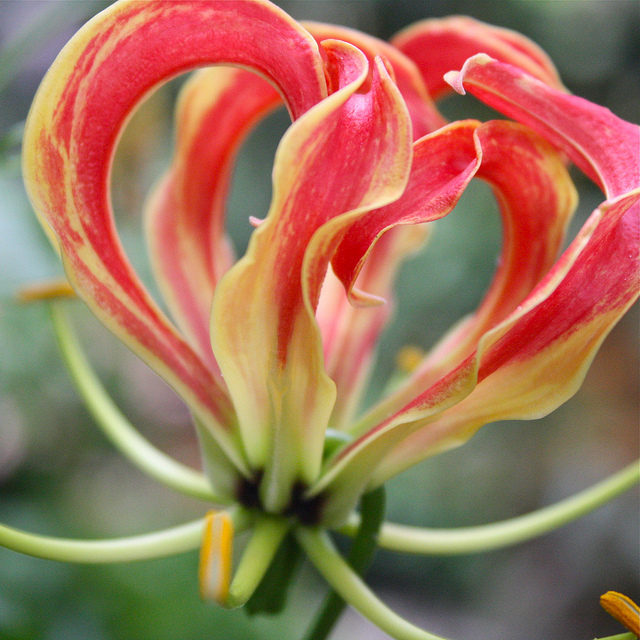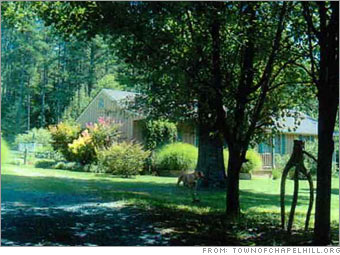 Landscapers have touted their industry as “green” for years. It’s true they work with green material, in the form of plants, but as far as being sustainable and environmentally friendly, the industry has a lot of work to do. Millions of tons of chemicals are applied to our home landscapes each year, including chemicals linked to cancer, birth defects and other health and ecological concerns. Our irrigation systems waste huge amounts of water. Many of our worst weeds are escapees from home landscapes. Whether you take care of your landscape yourself or hire out the work, I think we can do better. And the good news is that although it might take a little bit more forethought or research at the outset, an environmentally friendly approach to home landscaping can be less expensive, less labor intensive and healthier. If you make decisions about your landscape, I urge you to put in the effort at the start and make those decisions with the environment (and your family’s health) in mind. I hope some of these suggestions help you as you make those decisions. Next month I’ll follow-up with more tips and several resources to help you in these endeavors.
Landscapers have touted their industry as “green” for years. It’s true they work with green material, in the form of plants, but as far as being sustainable and environmentally friendly, the industry has a lot of work to do. Millions of tons of chemicals are applied to our home landscapes each year, including chemicals linked to cancer, birth defects and other health and ecological concerns. Our irrigation systems waste huge amounts of water. Many of our worst weeds are escapees from home landscapes. Whether you take care of your landscape yourself or hire out the work, I think we can do better. And the good news is that although it might take a little bit more forethought or research at the outset, an environmentally friendly approach to home landscaping can be less expensive, less labor intensive and healthier. If you make decisions about your landscape, I urge you to put in the effort at the start and make those decisions with the environment (and your family’s health) in mind. I hope some of these suggestions help you as you make those decisions. Next month I’ll follow-up with more tips and several resources to help you in these endeavors.
- Right plant—right place. Make sure plants you choose are well suited to the conditions of the site (my favorite resource for this is The Southern Living Garden Book). This will give you healthier plants and save you time and money with less maintenance, water, fertilizer and pesticides (and fewer replacement plants to buy).
- Avoid plants that require lots of chemical inputs. Rose breeders have gotten the message and now produce disease-resistant varieties (although they’re still heavy feeders). Before shopping for plants, research which varieties thrive without chemical pampering.
- Plant natives. Natives are usually less bothered by pests and diseases and are much more utilized by wildlife. They are adapted to our environment and won’t require pampering—less watering, less chemicals, less work. They also pose no threat of “escaping” into the wild (to be our next kudzu or cogongrass). Very few exotic plants are larval food for our butterflies.
- Xeriscape. By choosing drought tolerant plants, you can save water, work and money.
- Buy locally produced plants to get plants adapted to your environment and to minimize the pollution associated with shipping, and the transport of invasive species. (Hitching rides in nursery products is how fire ants conquered the Southeast.)
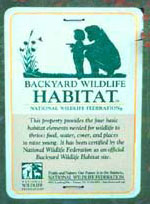 Plant for wildlife. You can offset some of the habitat loss caused by development. Consider applying for the National Wildlife Federation’s “Backyard Wildlife Habitat” designation.
Plant for wildlife. You can offset some of the habitat loss caused by development. Consider applying for the National Wildlife Federation’s “Backyard Wildlife Habitat” designation.- Plant a diverse selection of plants. Plant diseases and pests love to spread from one specimen of a plant to a neighboring plant of the same type. A diverse garden means less disease and fewer pests and better looking and better yielding plants—and less toxic pesticides.
- Plant trees. They clean the air, reduce noise, sequester carbon dioxide, create oxygen, moderate storm water run-off and erosion, and lower our summer temperatures by creating shade and by evaporating water. The services provided by a large tree would cost tens of thousands of dollars every year if you had to pay for them. Start with http://hort.ifas.ufl.edu/woody/index.shtml for info on trees.
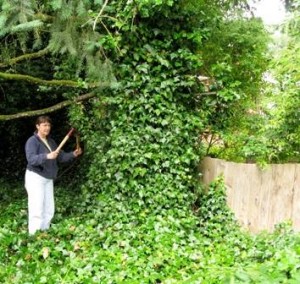 Avoid plants suspected to be invasive or potentially invasive. Many of the world’s worst weeds are escapees from horticulture. And many of them are still for sale (Japanese honeysuckle, English Ivy, Asian wisterias, nandina, eleagnus, privet, cogongrass, among many others).
Avoid plants suspected to be invasive or potentially invasive. Many of the world’s worst weeds are escapees from horticulture. And many of them are still for sale (Japanese honeysuckle, English Ivy, Asian wisterias, nandina, eleagnus, privet, cogongrass, among many others).- Don’t let your English ivy climb—if made to grow horizontally, it stays in juvenile mode and won’t produce seeds that can be spread by birds to natural areas.
- Soil test. By having your soil chemically analyzed, you’ll know what to apply to get pH and nutrient levels optimal. Optimal soil chemistry means healthier plants, less waste (and less expense and potential run-off pollutants). Clemson Extension offices will accept soil for testing—for a modest $6, you’ll find out which fertilizer is best for what you want to grow and how much of it you’ll need, and the same for lime. See www.clemson.edu/extension/hgic/plants/other/soils/hgic1652.html.
- Water wisely. As infrequently as possible, and deeply when you do. And not when it’s raining.
- Know what your maintenance contractor is applying. If you don’t need a pre-emergent weed control or an insecticide application, don’t let him apply it. If he says you have a grub problem, ask him to show you where he sampled the turf (don’t treat unless there are more than ten grubs per square foot). If he says you have mole crickets, ask which species (they are not all pests). Consider that when you walk on the lawn, you’ll track the chemicals on it back into your house.
- If you can’t do the maintenance yourself, hire a maintenance contractor who practices organic methods, Integrated Pest Management, or at a minimum, scientifically sound methods. Ask if the people working on your property are certified landscape technicians. Be wary of a firm willing to fertilize and lime without first having the soil analyzed.
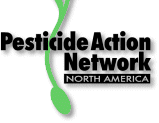 Opt for the least toxic solution to problems. EPA approved chemicals aren’t always safe. Think about all of the chemicals pulled from the market because we found they were dangerous to our health or the environment only after they were on the market. Research what you’re planning to use. Places to start are the Pesticide Action Network (www.panna.org), the EPA (www.epa.gov), Beyond Pesticides (www.beyondpesticides.org) and the Washington Toxics Coalition (www.watoxics.org).
Opt for the least toxic solution to problems. EPA approved chemicals aren’t always safe. Think about all of the chemicals pulled from the market because we found they were dangerous to our health or the environment only after they were on the market. Research what you’re planning to use. Places to start are the Pesticide Action Network (www.panna.org), the EPA (www.epa.gov), Beyond Pesticides (www.beyondpesticides.org) and the Washington Toxics Coalition (www.watoxics.org).- When you use chemicals, follow the label to the letter. Use the prescribed equipment, wear the appropriate clothing, apply the correct dose at the correct time on the correct target, and clean-up and store the leftovers appropriately.
- Use biological controls when appropriate. There aren’t many for sale locally, but there are scores available by mail. Look beyond ladybeetles, which are prone to fly away.
- Re-use bricks, concrete, furniture. Re-purpose other items as planters and trellises.
- Lower your standards and tolerate a few weeds and a small amount of insect damage.
- Avoid gas engines when human-powered and electric alternatives are available. Reel mowers and hand saws are good exercise. Pollution control devices are not mandated on mowers, blowers and other garden tools, so they can pollute more than cars and trucks.
- Follow best-management practices in planting, pruning, mowing, watering. Well cared for plants will have fewer disease and pest problems.
- Handpick weeds before they reproduce and get out of hand. Or hire a few kids to pull weeds (first teaching them what is a weed and what is a desirable plant).
- Organic fertilizers—use’em!
- Know your target pest before spraying. Most bugs are beneficial or innocent bystanders.
- Don’t spray fall webworms. The leaves of the host trees will be lost soon anyway, so the webworms’ damage will not hurt the trees. With webworms and tent caterpillars, you can open the webbing with a stick to let birds get the worms.


